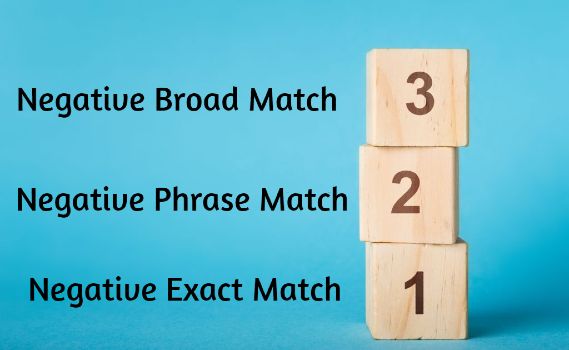Why Negative Keywords Are Essential In Google Ads

If you’ve never heard of negative keywords, you’re probably wasting a lot of money on Adwords.
You probably know the most profitable keywords are the ones that get you the most clicks and conversions. But do you have such a precise vision of the keywords that weigh down your performance and your return on investment?
According to Wordstream, only one in two advertisers adds negative keywords to their campaigns every month.
If you don’t have one yet, building a negative keyword list in AdWords is essential for improving the targeting and ROI of your campaigns.
What Is A Negative Keyword In AdWords?
A negative keyword is a search term for which you do not want your AdWords ad to appear in Google results.
These are, most often, expressions close to your keywords or namesakes that have nothing to do with the product or service you want to promote.
For example, if you’re an optician promoting your business online, you will have to exclude search terms such as “drinking glasses” or “wine glasses” to ensure that your ad does not appear on these keywords.
6 Advantages Obtained By Excluding Keywords

The use of negative keyword lists will allow you to better target Internet users who type queries really related to the offer on your website and maximize the good clicks of potential customers.
- Your click through rate (CTR) will increase significantly by generating much more qualitative traffic.
- You can better assess the relevance of your Google Ads ad extensions.
- With your traffic being of higher quality, your conversion rate will improve, thereby ensuring a better return on investment and more targeted prospects.
- The overall Quality Score of your account will be pulled up thanks to the relevance of your keywords, ad group and your CTR increase. The bounce rate on the landing page will be improved.
- The CPC of your keywords will decrease, and the positioning of your ads will be better at the same or lower price, improving your ROI.
- You can avoid legal and ethical problems by excluding trademarks, competitors, etc. and prevent the display of your ads on those keywords.
Types Of Negative Keywords

In AdWords, it is possible to add negative keywords in three different ways. They can be used for a particular ad group or an entire campaign depending on how your ads are structured.
1. Negative Broad Match
If you choose the negative broad match option, your ad will not be shown in the search query contains all your negative keywords, even if the words appear in a different order.
However, if the search query includes only some of your negative keywords terms, your ad may be shown.
For example, if your chosen negative broad match keyword is jogging shoes, your ad will be shown for black sports shoes & jogging shoes. It is not be shown if someone searches for white jogging shoes, shoes jogging & jogging shoes.
2. Negative Phrase Match
For the negative phrase match option, your ad will not appear if the search query contains the exact keyword terms in the same order. Provided the keyword terms appear in the same order, your ad will not be shown even if additional terms are added to the keyword.
For example, if you choose the term jogging shoes as your negative phrase match, you add be the shown for white sports shoes, jogging shoes, shoes jogging & black jogging shoes. It will not be shown if the Internet user searches for black jogging shoes & jogging shoes.
3. Negative Exact Match
Choosing the negative exact match option will result in your ad not being shown only if the exact keyword terms are searched. Plus, the keywords should appear in the same order and without any extra words added before & after. If that’s not the case, your ad may be shown.
For example, if you choose jogging shoes as your negative exact match, your ad will not be shown only with the term jogging shoes is searched. For other variations like red jogging shoes, shoes jogging, jogging shoes, blue sneaker shoes, etc. your ad will be shown.
How To Choose The Right Negative Keywords?

It is important to handle keyword exclusion with tact and moderation. Some exclusions that are too drastic can cause you to miss out on very interesting traffic opportunities.
This research and exclusion work will be done at all stages of your campaign: at its creation by anticipating the obvious keywords to exclude immediately, and throughout its life by analyzing the various statistics for your keywords.
Examine the “Search Terms” tab in AdWords
The most obvious way to define your negative keywords is to look at the list of search terms that trigger your ad to appear. To do this, in AdWords, go to Keywords > Search terms.
In this list, you should spot irrelevant search terms that still cause your ad to appear. Add them to your negative keywords to refine your AdWords campaign targeting and increase your return on investment.
- If you identify a search term that is not relevant enough to the products or services you offer, add it as a negative keyword. (“Cheap” if your site is upscale, “second-hand” if you sell new products, “men” if you only sell for women, etc.)
- If you identify keywords that generate a lot of clicks but no or few conversions you can exclude it if you think that in the long run it will not be profitable.
- If you identify keywords that generate a lot of impressions but few clicks, exclude them to increase your CTR.
Use the keyword planning tool
While the Keyword Planner is primarily about finding new keyword ideas to use in your ads, it’s also a very effective way to spot negative keywords.
A large proportion of the keywords displayed might have no connection with your activity so you can add these expressions to your list of negative keywords.
Do a Google search
By typing different keywords in the Google search bar, the most typed keywords will be offered in the search bar suggestions.
Other suggestions will also be offered at the bottom of the results page. Identify recurring keywords that are not relevant but associated to other keywords that are relevant to you and exclude them.
Use your imagination
Put yourself in the shoes of Internet users and ask yourself which terms can be added to your main keywords and generate irrelevant combinations.
- If you sell paid services, do you want to keep queries with the words: free, discount, cheap, used, etc.
- If you sell products for children, do you want to keep queries with the words: man, woman, etc.
- If you sell hairdressing services, do you want to keep queries with the words: training center, job, job, resume, blog, video, etc.
Negative keywords best practices
- The use of only the following three symbols allowed in negative keywords – accent marks (á), ampersands (&) and asterisks (*).
- Negative keywords that have accent marks are considered two different negative keywords. For example, sidewalk cafe and sidewalk café.
- If a user query is longer than 16 words and your negative keyword follows that 16th word, your ad might still be shown, irrespective of the match type you choose.
- Ensure that your negative keywords don’t intersect with your regular keywords for which you want your ad to display, because this will cause your ad not to show.
- Don’t add too many negative keywords at once. It will do more harm than good because it will be difficult for you to pinpoint what’s working and what’s not.
- If you want to add negative keywords to multiple campaigns, use negative keywords lists instead of manually adding negative keywords to each campaign.
Final Thoughts
Choosing the right keywords for your Google Ads campaigns is a prerequisite for your campaigns to be effective.
But completing this step without having selected the negative words reduces your chances of appearing in the right searches.
Once you find your negative keywords and add them to an ad group or campaign, don’t forget to constantly refine your ad targeting through them.